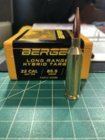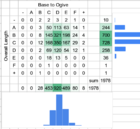Tested this morning. Still getting used to the Lab Radar so the data are sparse;
Case: Winchester
Primer: CCI BR
Jump: .015
Load: 24.6 grains N140 (started at 24.2 and worked up in .1 grain increments)
Chamber Reamer: Jerry Tierney design for 90 grain bullet per owner of the reamer
Rifle: Barnard/30 in Kreiger 1:7 twist
MV: 2824,2841,2842,2839
No extraction problems, primers flattened but still rounded at the edges
Need to do more testing. Looking for 2900+
CAUTION: AS usual this is what worked in my rifle so don't use it as a starting point nor as an absolute!
Case: Winchester
Primer: CCI BR
Jump: .015
Load: 24.6 grains N140 (started at 24.2 and worked up in .1 grain increments)
Chamber Reamer: Jerry Tierney design for 90 grain bullet per owner of the reamer
Rifle: Barnard/30 in Kreiger 1:7 twist
MV: 2824,2841,2842,2839
No extraction problems, primers flattened but still rounded at the edges
Need to do more testing. Looking for 2900+
CAUTION: AS usual this is what worked in my rifle so don't use it as a starting point nor as an absolute!












